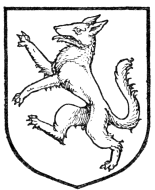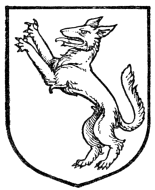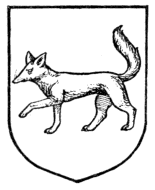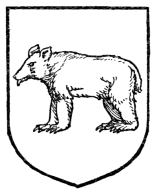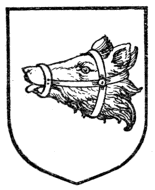
Fig. 317.—Arms of Bohemia, from the "Pulver Turme" at Prague. (Latter half of the fifteenth century.)
Before leaving the lion, the hint may perhaps be usefully conveyed that the temptation to over-elaborate the lion when depicting it heraldically should be carefully avoided. The only result is confusion—the very contrary of the essence of heraldic emblazonment, which was, is, and should be, the method of clear advertisement of identity. Examples of over-elaboration can, however, be found in the past, as will be seen from Fig. 317. This example belongs to the latter half of the fifteenth century, and represents the arms of Bohemia. It is taken from a shield on the "Pulver Turme" at Prague.
Parts of lions are very frequently to be met with, particularly as crests. In fact the most common crest in existence is the demi-lion rampant (Fig. 318). This is the upper half of a lion rampant. It is comparatively seldom found other than rampant and couped, so that the term "a demi-lion," unless otherwise qualified, may always be assumed to be a demi-lion rampant couped. As charges upon the shield three will be found in the arms of Bennet, Earl of Tankerville: "Gules, a bezant between three demi-lions rampant argent."
The demi-lion may be both guardant and regardant.
Demi-lions rampant and erased are more common as charges than as crests. They are to be found in several Harrison coats of arms.
Demi-lions passant (Fig. 319) are rather unusual, but in addition to the seeming cases in which they occur by dimidiation they are sometimes found, as in the case of the arms of Newman.
Demi-lion affronté.—The only case which has come under notice would appear to be the crest of Campbell of Aberuchill.
Demi-lion issuant.—This term is applied to a demi-lion when it issues from an ordinary, e.g. from the base line of the chief, as in the arms of Dormer, Markham, and Abney; or from behind a fesse, as in the arms of Chalmers.
Demi-lion naissant issues from the centre of an ordinary, and not from behind it.
Lions' heads, both couped (Fig. 320) and erased, are very frequently met with both as charges on the shield and as crests.
Lion's gamb.—Many writers make a distinction between the gamb (which is stated to be the lower part only, couped or erased half-way up the leg) and the paw, but this distinction cannot be said to be always rigidly observed. In fact some authorities quote the exact reverse as the definition of the terms. As charges the gamb or paw will be found to occur in the arms of Lord Lilford ["Or, a lion's gamb erased in bend dexter between two crosslets fitchée in bend sinister gules"], and in the arms of Newdigate. This last is a curious example, inasmuch as, without being so specified in the blazon, the gambs are represented in the position occupied by the sinister foreleg of a lion passant.
The crest upon the Garter Plate of Edward Cherleton, Lord Cherleton of Powis, must surely be unique. It consists of two lions' paws embowed, the outer edge of each being adorned with fleurs-de-lis issuant therefrom.
A lion's tail will sometimes be found as a crest, and it also occurs as a charge in the arms of Corke, viz.: "Sable, three lions' tails erect and erased argent."
A lion's face (Fig. 321) should be carefully distinguished from a lion's head. In the latter case the neck, either couped or erased, must be shown; but a lion's face is affronté and cut off closely behind the ears. The distinction between the head and the face can be more appropriately considered in the case of the leopard.
CHAPTER XII
BEASTS
Next after the lion should be considered the tiger, but it must be distinctly borne in mind that heraldry knows two kinds of tigers—the heraldic tiger (Figs. 322 and 323) and the Bengal tiger (Figs. 324 and 325). Doubtless the heraldic tiger, which was the only one found in British armory until a comparatively recent date, is the attempt of artists to depict their idea of a tiger. The animal was unknown to them, except by repute, and consequently the creature they depicted bears little relation to the animal of real life; but there can be no doubt that their intention was to depict an animal which they knew to exist. The heraldic tiger had a body much like the natural tiger, it had a lion's tufted tail and mane, and the curious head which it is so difficult to describe, but which appears to be more like the wolf than any other animal we know. This, however, will be again dealt with in the chapter on fictitious animals, and is here only introduced to demonstrate the difference which heraldry makes between the heraldic tiger and the real animal. A curious conceit is that the heraldic tiger will anciently be often found spelt "tyger," but this peculiar spelling does not seem ever to have been applied to the tiger of nature.
When it became desirable to introduce the real tiger into British armory as typical of India and our Eastern Empire, something of course was necessary to distinguish it from the tyger which had previously usurped the name in armory, and for this reason the natural tiger is always heraldically known as the Bengal tiger. This armorial variety appears towards the end of the eighteenth century in this country, though in foreign heraldry it appears to have been recognised somewhat earlier. There are, however, but few cases in which the Bengal tiger has appeared in armory, and in the majority of these cases as a supporter, as in the supporters of Outram, which are two tigers rampant guardant gorged with wreaths of laurel and crowned with Eastern crowns all proper. Another instance of the tiger as a supporter will be found in the arms of Bombay. An instance in which it appears as a charge upon a shield will be found in the arms granted to the University of Madras.
Another coat is that granted in 1874 to Augustus Beaty Bradbury of Edinburgh, which was: "Argent, on a mount in base vert, a Bengal tiger passant proper, on a chief of the second two other tigers dormant also proper." A tigress is said to be occasionally met with, and when so, is sometimes represented with a mirror, in relation to the legend that ascribes to her such personal vanity that her young ones might be taken from under her charge if she had the counter attraction of a hand-glass! At least so say the heraldry books, but I have not yet come across such a case.
The leopard (Figs. 326, 327, and 328) has to a certain extent been referred to already. Doubtless it is the peculiar cat-like and stealthy walk which is so characteristic of the leopard which led to any animal in that position being considered a leopard; but the leopard in its natural state was of course known to Europeans in the early days of heraldry, and appears amongst the lists of heraldic animals apart from its existence as "a lion passant." The animal, however, except as a supporter or crest, is by no means common in English heraldry. It will be found, however, in the crests of some number of families; for example, Taylor and Potts.
A very similar animal is the ounce, which for heraldic purposes is in no way altered from the leopard. Parts of the latter will be found in use as in the case of the lion. As a crest the demi-leopard, the leopard's head (Fig. 329), and the leopard's head affronté (Fig. 330) are often to be met with. In both cases it should be noticed that the neck is visible, and this should be borne in mind, because this constitutes the difference between the leopard's head and the leopard's face (Fig. 331). The leopard's face is by far the most usual form in which the leopard will be found in armory, and can be traced back to quite an early period in heraldry. The leopard's face shows no neck at all, the head being removed close behind the ears. It is then represented affronté. For some unfathomable reason these charges when they occur in the arms of Shrewsbury are usually referred to locally as "loggerheads." They were perpetuated in the arms of the county in its recent grant. A curious development or use of the leopard's face occurs when it is jessant-de-lis (Fig. 332). This will be found referred to at greater length under the heading of the Fleur-de-lis.
The panther is an animal which in its relation to heraldry it is difficult to know whether to place amongst the mythical or actual animals. No instance occurs to me in which the panther figures as a charge in British heraldry, and the panther as a supporter, in the few cases in which it is met with, is certainly not the actual animal, inasmuch as it is invariably found flammant, i.e. with flames issuing from the mouth and ears. In this character it will be found as a supporter of the Duke of Beaufort, and derived therefrom as a supporter of Lord Raglan. Foreign heraldry carries the panther to a most curious result. It is frequently represented with the tail of a lion, horns, and for its fore-legs the claws of an eagle. Even in England it is usually represented vomiting flames, but the usual method of depicting it on the Continent is greatly at variance with our own. Fig. 333 represents the same arms of Styria—Vert, a panther argent, armed close, vomiting flames of fire—from the title-page of the Land-bond of Styria in the year 1523, drawn by Hans Burgkmair. In Physiologus, a Greek writing of early Christian times of about the date 140, which in the course of time has been translated into every tongue, mention is made of the panther, to which is there ascribed the gaily spotted coat and the pleasant, sweet-smelling breath which induces all other animals to approach it; the dragon alone retreats into its hole from the smell, and consequently the panther appears to have sometimes been used as a symbol of Christ. The earliest armorial representations of this animal show the form not greatly dissimilar to nature; but very soon the similarity disappears in Continental representations, and the fancy of the artist transferred the animal into the fabulous creature which is now represented. The sweet-smelling breath, suozzon-stanch as it is called in the early German translation of the Physiologus, was expressed by the flames issuing from the mouth, but later in the sixteenth century flames issued from every opening in the head. The head was in old times similar to that of a horse, occasionally horned (as in the seal of Count Heinrich von Lechsgemünd, 1197); the fore-feet were well developed. In the second half of the fourteenth century the fore-feet assume the character of eagles' claws, and the horns of the animal were a settled matter. In the neighbourhood of Lake Constance we find the panther with divided hoofs on his hind-feet; perhaps with a reference to the panther's "cleanness." According to the Mosaic law, of course, a four-footed animal, to be considered clean, must not have paws, and a ruminant must not have an undivided hoof. Italian heraldry is likewise acquainted with the panther, but under another name (La Dolce, the sweet one) and another form. The dolce has a head like a hare, and is unhorned. (See A. Anthony v. Siegenfeld, "The Territorial Arms of Styria," Graz, 1898.)
The panther is given by Segar, Garter King of Arms 1603-1663, as one of the badges of King Henry VI., where it is silver, spotted of various colours, and with flames issuing from its mouth and ears. No doubt this Royal badge is the origin of the supporter of the Duke of Beaufort.
English armory knows an animal which it terms the male griffin, which has no wings, but which has gold rays issuing from its body in all directions. Ströhl terms the badge of the Earls of Ormonde, which from his description are plainly male griffins, keythongs, which he classes with the panther; and probably he is correct in looking upon our male griffin as merely one form of the heraldic panther.
The cat, under the name of the cat, the wild cat, the cat-a-mountain, or the cat-a-mount (Figs. 334, 335, and 336), is by no means infrequent in British armory, though it will usually be found in Scottish or Irish examples. The arms of Keates and Scott-Gatty in which it figures are English examples, however.
The wolf (Figs. 337-341) is a very frequent charge in English armory. Apart from its use as a supporter, in which position it is found in conjunction with the shields of Lord Welby, Lord Rendell, and Viscount Wolseley, it will be found in the arms of Lovett and in by far the larger proportion of the coats for the name of Wilson and in the arms of Low.
The wolf, however, in earlier representations has a less distinctly wolf-like character, it being sometimes difficult to distinguish the wolf from some other heraldic animals. This is one of these cases in which, owing to insufficient knowledge and crude draughtsmanship, ancient heraldry is not to be preferred to more realistic treatment. The demi-wolf is a very frequent crest, occurring not only in the arms and crests of members of the Wilson and many other families, but also as the crest of Wolfe. The latter crest is worthy of remark, inasmuch as the Royal crown which is held within its paws typifies the assistance given to King Charles II., after the battle of Worcester, by Mr. Francis Wolfe of Madeley, to whom the crest was granted. King Charles, it may be noted, also gave to Mr. Wolfe a silver tankard, upon the lid of which was a representation of this crest. Wolves' heads are particularly common, especially in Scottish heraldry. An example of them will be found in the arms of "Struan" Robertson, and in the coats used by all other members of the Robertson Clan having or claiming descent from, or relationship with, the house of Struan. The wolf's head also appears in the arms of Skeen. Woodward states that the wolf is the most common of all heraldic animals in Spanish heraldry, where it is frequently represented as ravissant, i.e. carrying the body of a lamb in its mouth or across its back.
Much akin to the wolf is the Lynx; in fact the heraldic representation of the two animals is not greatly different. The lynx does not often occur in heraldry except as a supporter, but it will be found as the crest of the family of Lynch. The lynx is nearly always depicted and blazoned "coward," i.e. with its tail between its legs (Fig. 342). Another instance of this particular animal is found in the crest of Comber.
A Fox (Figs. 343 and 344) which from the similarity of its representation is often confused with a wolf, is said by Woodward to be very seldom met with in British heraldry. This is hardly a correct statement, inasmuch as countless instances can be produced in which a fox figures as a charge, a crest, or a supporter. The fox is found on the arms and as the crest, and two are the supporters of Lord Ilchester, and instances of its appearance will be found amongst others in the arms or crests, for example, of Fox, Colfox, and Ashworth. Probably the most curious example of the heraldic fox will be found in the arms of Sir Watkin Williams Wynn, who for the arms of Williams quarters: "Argent, two foxes counter-salient gules, the dexter surmounted of the sinister." The face of a fox is termed its mask (Fig. 345).
The Bear (Figs. 346-349) is frequently found figuring largely in coats of arms for the names of Barnard, Baring, Barnes, and Bearsley, and for other names which can be considered to bear canting relation to the charge. In fact the arms, crest, and motto of Barnard together form such an excellent example of the little jokes which characterise heraldry that I quote the blazon in full. The coat is "argent, a bear rampant sable," the crest is "a demi-bear sable," and the motto "Bear and forbear."
The bear is generally muzzled, but this must not be presumed unless mentioned in the blazon. Bears' paws are often found both in crests and as charges upon shields, but as they differ little if anything in appearance from the lion's gamb, they need not be further particularised. To the bear's head, however, considerable attention should be paid, inasmuch as the manner of depicting it in England and Scotland differs. The bear's head, according to English ideas of heraldry, would be depicted down to the shoulders, and would show the neck couped or erased (Fig. 350). In Scottish heraldry, bears' heads are almost invariably found couped or erased close behind the ears without any of the neck being visible (Figs. 351 and 352); they are not, however, represented as caboshed or affronté.
The Boar is an animal which, with its parts, will constantly be met with in British armory (Figs. 353-355). Theoretically there is a difference between the boar, which is the male of the domestic animal, and the wild boar, which is the untamed creature of the woods. Whilst the latter is usually blazoned as a wild boar or sanglier, the latter is just a boar; but for all practical purposes no difference whatever is made in heraldic representations of these varieties, though it may be noted that the crest of Swinton is often described as a sanglier, as invariably is also the crest of Douglas, Earl of Morton ["A sanglier sticking between the cleft of an oak-tree fructed, with a lock holding the clefts together all proper"]. The boar, like the lion, is usually described as armed and langued, but this is not necessary when the tusks are represented in their own colour and when the tongue is gules. It will, however, be very frequently found that the tusks are or. The "armed," however, does not include the hoofs, and if these are to be of any colour different from that of the animal, it must be blazoned "unguled" of such and such a tincture. Precisely the same distinction occurs in the heads of boars (Figs. 356-358) that was referred to in bears. The real difference is this, that whilst the English boar's head has the neck attached to the head and is couped or erased at the shoulders, the Scottish boar's head is separated close behind the ears. No one ever troubled to draw any distinction between the two for the purposes of blazon, because the English boars' heads were more usually drawn with the neck, and the boars' heads in Scotland were drawn couped or erased close. But the boars head in Welsh heraldry followed the Scottish and not the English type. Matters armorial, however, are now cosmopolitan, and one can no longer ascertain that the crest of Campbell must be Scottish, or that the crest of any other family must be English; and consequently, though the terms will not be found employed officially, it is just as well to distinguish them, because armory can provide means of such distinction—the true description of an English boar's head being couped or erased "at the neck," the Scottish term being a boar's head couped or erased "close."
Occasionally a boar's head will be stated to be borne erect; this is then shown with the mouth pointing upwards. A curious example of this is found in the crest of Tyrrell: "A boar's head erect argent, in the mouth a peacock's tail proper."
Woodward mentions three very strange coats of arms in which the charge, whilst not being a boar, bears very close connection with it. He states that among the curiosities of heraldry we may place the canting arms of Ham, of Holland: "Gules, five hams proper, 2, 1, 2." The Verhammes also bear: "Or, three hams sable." These commonplace charges assume almost a poetical savour when placed beside the matter-of-fact coat of the family of Bacquere: "d'Azur, à un ecusson d'or en abîme, accompagné de trois groins de porc d'argent," and that of the Wursters of Switzerland: "Or, two sausages gules on a gridiron sable, the handle in chief."
HORSES
It is not a matter of surprise that the horse is frequently met with in armory. It will be found, as in the arms of Jedburgh, carrying a mounted warrior (Fig. 359), and the same combination appears as the crest of the Duke of Fife.
The horse will be found rampant (or forcene, or salient) (Fig. 360), and will be found courant (Fig. 361), passant (Fig. 362), and trotting.
When it is "comparisoned" or "furnished" it is shown with saddle and bridle and all appurtenances; but if the saddle is not present it would only be blazoned "bridled."
"Gules, a horse argent," really the arms of Westphalia, is popularly known in this country as the coat of Hanover, inasmuch as it was the most prominent charge upon the inescutcheon or quartering of Hanover formerly borne with the Royal Arms. Every one in this country is familiar with the expression, "the white horse of Hanover."
Horses will also be found in many cases as supporters, and these will be referred to in the chapter upon that subject, but reference should be particularly made here to the crest of the family of Lane, of King's Bromley, which is a strawberry roan horse, couped at the flanks, bridled, saddled, and holding in its feet the Imperial crown proper. This commemorates the heroic action of Mistress Jane Lane, afterwards Lady Fisher, and the sister of Sir Thomas Lane, of King's Bromley, who, after the battle of Worcester and when King Charles was in hiding, rode from Staffordshire to the south coast upon a strawberry roan horse, with King Charles as her serving-man. For this the Lane family were first of all granted the canton of England as an augmentation to their arms, and shortly afterwards this crest of the demi-horse (Plate II.).
The arms of Trevelyan afford an interesting example of a horse, being: "Gules, issuant out of water in base proper, a demi-horse argent, hoofed and maned or."
The heads of horses are either so described or (and more usually) termed "nags' heads," though what the difference may be is beyond the comprehension of most people; at any rate heraldry knows of none.
The crest of the family of Duncombe is curious, and is as follows: "Out of a ducal coronet or, a horse's hind-leg sable, the shoe argent."
Though they can hardly be termed animate charges, perhaps one may be justified in here mentioning the horse-shoe (Fig. 363), which is far from being an uncommon charge. It will be found in various arms for the name of Ferrar, Ferrers, Farrer, and Marshall; and, in the arms of one Scottish family of Smith, three horse-shoes interlaced together form an unusual and rather a curious charge.
Other instances in which it occurs will be found in the arms of Burlton, and in the arms used by the town of Oakham. In the latter case it doubtless has reference to the toll of a horse-shoe, which the town collects from every peer or member of the Royal Family who passes through its limits. The collection of these, which are usually of silver, and are carefully preserved, is one of the features of the town.
The sea-horse, the unicorn, and the pegasus may perhaps be more properly considered as mythical animals, and the unicorn will, of course, be treated under that heading; but the sea-horse and the pegasus are so closely allied in form to the natural animal that perhaps it will be simpler to treat of them in this chapter. The sea-horse (Fig. 364) is composed of the head and neck of a horse and the tail of a fish, but in place of the fore-feet, webbed paws are usually substituted. Two sea-horses respecting each other will be found in the coat of arms of Pirrie, and sea-horses naiant will be found in the arms of M‘Cammond. It is a matter largely left to the discretion of the artist, but the sea-horse will be found as often as not depicted with a fin at the back of its neck in place of a mane. A sea-horse as a crest will be found in the case of Belfast and in the crests of Clippingdale and Jenkinson. The sea-horse is sometimes represented winged, but I know of no officially sanctioned example. When represented rising from the sea the animal is said to be "assurgeant."
The pegasus (Figs. 365 and 366), though often met with as a crest or found in use as a supporter, is very unusual as a charge upon an escutcheon. It will be found, however, in the arms of the Society of the Inner Temple and in the arms of Richardson, which afford an example of a pegasus rampant and also an example in the crest of a pegasus sejant, which at present is the only one which exists in British heraldry.
Fig. 367 gives a solitary instance of a mare. The arms, which are from Grünenberg's Wappenbuch (1483), are attributed to "Herr von Frouberg from the Forest in Bavaria," and are: Gules, a mare rampant argent, bridled sable.
The ass is not a popular charge, but the family of Mainwaring have an ass's head for a crest.
DOGS
Dogs will be found of various kinds in many English and Scottish coats of arms, though more frequently in the former than in the latter. The original English dog, the hound of early days, is, of course, the talbot (Figs. 368, 369, 370, and 371). Under the heading of supporters certain instances will be quoted in which dogs of various kinds and breeds figure in heraldry, but the talbot as a charge will be found in the arms of the old Staffordshire family, Wolseley of Wolseley, a cadet of which house is the present Field-Marshal Viscount Wolseley. The Wolseley arms are: "Argent, a talbot passant gules." Other instances of the talbot will be found in the arms or crests of the families of Grosvenor, Talbot, and Gooch. The arms "Azure, three talbots statant or," were granted by Cooke to Edward Peke of Heldchurchgate, Kent. A sleuth-hound treading gingerly upon the points of a coronet ["On a ducal coronet, a sleuth-hound proper, collared and leashed gules"] was the crest of the Earl of Perth and Melfort, and one wonders whether the motto, "Gang warily," may not really have as much relation to the perambulations of the crest as to the dangerous foothold amongst the galtraps which is provided for the supporters.




















